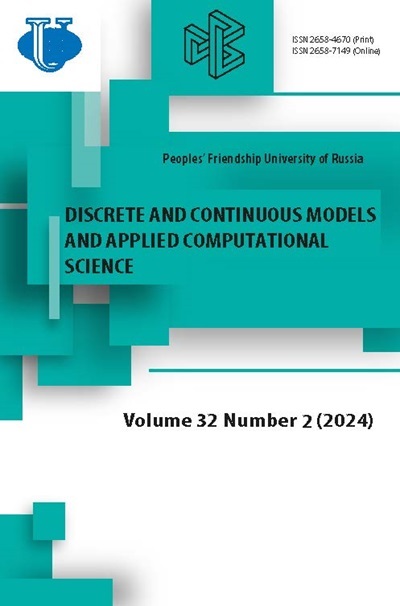Метод коллокации Чебышева для решения ОДУ второго порядка с использованием матриц интегрирования
- Авторы: Ловецкий К.П.1, Кулябов Д.С.1,2, Севастьянов Л.А.1,2, Сергеев С.В.1
-
Учреждения:
- Российский университет дружбы народов
- Объединённый институт ядерных исследований
- Выпуск: Том 31, № 2 (2023)
- Страницы: 150-163
- Раздел: Статьи
- URL: https://journals.rudn.ru/miph/article/view/35111
- DOI: https://doi.org/10.22363/2658-4670-2023-31-2-150-163
- EDN: https://elibrary.ru/WFZCIO
Цитировать
Полный текст
Аннотация
Реализован метод спектральной коллокации для решения двухточечных краевых задач для дифференциальных уравнений второго порядка, основанный на представлении решения в виде разложения по полиномам Чебышева. Подход позволяет устойчиво вычислять как спектральное представление решения, так и его поточечное представление на любой необходимой сетке в области определения уравнения и дополнительных условий многоточечной задачи. Для эффективного построения СЛАУ, решение которой дает искомые коэффициенты, активно используются матрицы Чебышева спектрального интегрирования. Предложенные алгоритмы обладают высокой точностью для систем линейных алгебраических уравнений средней размерности. Матрица системы остается хорошо обусловленной и с увеличением количества точек коллокации позволяет находить решения со все возрастающей точностью.
Об авторах
К. П. Ловецкий
Российский университет дружбы народов
Email: lovetskiy-kp@rudn.ru
ORCID iD: 0000-0002-3645-1060
Candidate of Sciences in Physics and Mathematics, Associate Professor of Department of Applied Probability and Informatics
ул. Миклухо-Маклая, д. 6, Москва, 117198, РоссияД. С. Кулябов
Российский университет дружбы народов; Объединённый институт ядерных исследований
Автор, ответственный за переписку.
Email: kulyabov-ds@rudn.ru
ORCID iD: 0000-0002-0877-7063
Professor, Doctor of Sciences in Physics and Mathematics, Professor at the Department of Applied Probability and Informatics of Peoples’ Friendship University of Russia named after Patrice Lumumba (RUDN University); Senior Researcher of Laboratory of Information Technologies, Joint Institute for Nuclear Research
ул. Миклухо-Маклая, д. 6, Москва, 117198, Россия; ул. Жолио-Кюри, д. 6, Дубна, Московская область, 141980, РоссияЛ. А. Севастьянов
Российский университет дружбы народов; Объединённый институт ядерных исследований
Email: sevastianov-la@rudn.ru
ORCID iD: 0000-0002-1856-4643
Professor, Doctor of Sciences in Physics and Mathematics, Professor at the Department of Applied Probability and Informatics of Peoples’ Friendship University of Russia named after Patrice Lumumba (RUDN University); Leading Researcher of Bogoliubov Laboratory of Theoretical Physics, Joint Institute for Nuclear Research
ул. Миклухо-Маклая, д. 6, Москва, 117198, Россия; ул. Жолио-Кюри, д. 6, Дубна, Московская область, 141980, РоссияС. В. Сергеев
Российский университет дружбы народов
Email: 1142220124@rudn.ru
ORCID iD: 0009-0004-1159-4745
PhD student of Department of Applied Probability and Informatics
ул. Миклухо-Маклая, д. 6, Москва, 117198, РоссияСписок литературы
- V. A. Soifer, Diffraction computer optics [Difraktsionnaya komp’yuternaya optika]. M.: FIZMATLIT, 2007, in Russian.
- A. A. Egorov and L. A. Sevastianov, “Structure of modes of a smoothly irregular integrated-optical four-layer three-dimensional waveguide,” Quantum Electronics, vol. 39, no. 6, pp. 566-574, Jun. 2009. DOI: 10. 1070/QE2009v039n06ABEH013966.
- A. L. Sevastianov, “Asymptotic method for constructing a model of adiabatic guided modes of smoothly irregular integrated optical waveguides,” Discrete and Continuous Models and Applied Computational Science, vol. 28, no. 3, pp. 252-273, 2020. doi: 10.22363/2658-4670-2020-28-3-252-273.
- A. L. Sevastianov, “Single-mode propagation of adiabatic guided modes in smoothly irregular integral optical waveguides,” Discrete and Continuous Models and Applied Computational Science, vol. 28, no. 4, pp. 361-377, 2020. doi: 10.22363/2658-4670-2020-28-4-361-377.
- L. Greengard, “Spectral integration and two-point boundary value problems,” SIAM Journal on Numerical Analysis, vol. 28, no. 4, pp. 1071-1080, 1991. doi: 10.1137/0728057.
- A. Amiraslani, R. M. Corless, and M. Gunasingam, “Differentiation matrices for univariate polynomials,” Numerical Algorithms, vol. 83, no. 1, pp. 1-31, 2020. doi: 10.1007/s11075-019-00668-z.
- J. P. Boyd, Chebyshev and Fourier spectral methods, second. Dover Books on Mathematics, 2013.
- J. C. Mason and D. C. Handscomb, Chebyshev polynomials. New York: Chapman and Hall/CRC Press, 2002. doi: 10.1201/9781420036114.
- S. E. El-gendi, “Chebyshev solution of differential, integral and integrodifferential equations,” The Computer Journal, vol. 12, no. 3, pp. 282-287, Aug. 1969. doi: 10.1093/comjnl/12.3.282.
- L. N. Trefethen, “Is Gauss quadrature better than Clenshaw-Curtis?” SIAM Review, vol. 50, no. 1, pp. 67-87, 2008. doi: 10.1137/060659831.
- L. A. Sevastianov, K. P. Lovetskiy, and D. S. Kulyabov, “A new approach to the formation of systems of linear algebraic equations for solving ordinary differential equations by the collocation method [Novyy podkhod k formirovaniyu sistem lineynykh algebraicheskikh uravneniy dlya resheniya obyknovennykh differentsial’nykh uravneniy metodom kollokatsiy],” Izvestiya of Saratov University. Mathematics. Mechanics. Informatics, vol. 23, no. 1, pp. 36-47, 2023, in Russian. doi: 10.18500/1816-9791-2023-23-1-36-47.
- N. Egidi and P. Maponi, “A spectral method for the solution of boundary value problems,” Applied Mathematics and Computation, vol. 409, p. 125 812, 2021. doi: 10.1016/j.amc.2020.125812.
- H. B. Keller, Numerical methods for two-point boundary value problems. Boston: Ginn-Blaisdell, 1968.
- D. Gottlieb and S. A. Orszag, Numerical analysis of spectral methods. Philadelphia, PA: Society for Industrial and Applied Mathematics, 1977.
- J. F. Epperson, An introduction to numerical methods and analysis, second. John Wiley & Sons, Inc, 2013.
- X. Zhang and J. P. Boyd, Asymptotic coefficients and errors for Chebyshev polynomial approximations with weak endpoint singularities: effects of different bases, 2022. doi: 10.48550/arXiv.2103.11841.
- J. P. Boyd and D. H. Gally, “Numerical experiments on the accuracy of the Chebyshev-Frobenius companion matrix method for finding the zeros of a truncated series of Chebyshev polynomials,” Journal of Computational and Applied Mathematics, vol. 205, no. 1, pp. 281-295, 2007. doi: 10.1016/j.cam.2006.05.006.
- B. Fornberg, A practical guide to pseudospectral methods. New York: Cambridge University Press, 1996.
- F. Rezaei, M. Hadizadeh, R. Corless, and A. Amiraslani, “Structural analysis of matrix integration operators in polynomial bases,” Banach Journal of Mathematical Analysis, vol. 16, no. 1, p. 5, 2022. DOI: 10. 1007/s43037-021-00156-4.
- L. C. Young, “Orthogonal collocation revisited,” Computer methods in Applied Mechanics and Engineering, vol. 345, pp. 1033-1076, 2019. doi: 10.1016/j.cma.2018.10.019.
- S. Olver and A. Townsend, “A fast and well-conditioned spectral method,” SIAM Review, vol. 55, no. 3, pp. 462-489, 2013. doi: 10.1137/120865458.
- M. Planitz et al., Numerical recipes: the art of scientific computing, 3rd Edition. New York: Cambridge University Press, 2007.
- L. A. Sevastianov, K. P. Lovetskiy, and D. S. Kulyabov, “Multistage collocation pseudo-spectral method for the solution of the first order linear ODE,” in 2022 VIII International Conference on Information Technology and Nanotechnology (ITNT), 2022, pp. 1-6. doi: 10.1109/ITNT55410.2022.9848731.
















